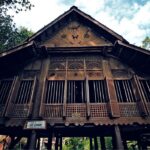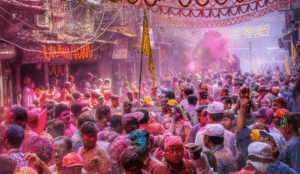The History and Significance of Wayang Kulit in Malay Culture, Sarawak
In the world of traditional performing arts, few cultural treasures are as mesmerizing and symbolic as wayang kulit. Known widely as the shadow puppet theatre of Southeast Asia, it’s a form of storytelling that combines puppetry, music, narration, and spiritual symbolism. In Sarawak, Malaysia, this ancient art form continues to echo the myths, wisdom, and values of generations past. Though it originated in Java, Indonesia, shadow puppetry has found deep roots in Malay culture, especially in Peninsular Malaysia and parts of Borneo.
Frequently Asked Question (FAQ):
1. What is wayang kulit in Malay culture?
Shadow puppetry is a traditional shadow puppet theatre that plays a central role in Malay cultural heritage. It combines puppetry, music, narration, and spiritual symbolism to tell epic stories, teach moral lessons, and preserve community values. In Malay culture, especially in Kelantan and parts of Sarawak, wayang kulit is not only a form of entertainment but also a spiritual and educational tool.
2. Who is the main performer in a wayang kulit show?
The main performer is known as the dalang. He is responsible for manipulating all the puppets, providing the voices of each character, and narrating the story. The dalang is considered both a master artist and a spiritual guide, playing a crucial role in preserving the integrity and cultural depth of the performance.
3. Is shadow puppet still popular?
While it faces challenges in the digital age, wayang kulit is experiencing a cultural revival in various parts of Malaysia, including Sarawak. Through community projects, school programs, and cultural festivals, the tradition is being kept alive by passionate performers, educators, and youth.
4. What is wayang kulit in Indonesia and Malaysia?
In Indonesia, particularly Java and Bali, shadow puppet is often based on Hindu epics like the Ramayana and Mahabharata, and it carries strong religious overtones. In Malaysia, the stories are often localized and infused with Malay folklore, Islamic influences, and local customs. Though different in themes and techniques, both versions share a deep respect for storytelling, performance, and spiritual symbolism.
5. Who is the most important person in a wayang kulit performance?
The dalang is undoubtedly the most important person in a wayang kulit performance. His voice, coordination, memory, and cultural knowledge bring the puppets to life. Without the dalang, the shadow play cannot function, making him the heart and soul of the entire experience.
Origins: The Roots of Shadow puppetry
The history of wayang kulit stretches back more than a thousand years. Scholars trace its origins to Java, where it blended elements of Hindu epics with local animist traditions. Some sources suggest that its earliest forms may have derived from religious rituals involving shadow casting and storytelling to communicate with spirits or honor ancestors. This unique synthesis of myth, spirituality, and visual storytelling gradually evolved into the stylized art of wayang kulit that we recognize today.
By the 14th century, wayang kulit had traveled across maritime Southeast Asia, brought along trade routes and through royal marriages. In Malaysia, especially in Kelantan and Terengganu, wayang kulit began to develop its own unique features, separate from its Javanese counterparts. Puppets in Malaysian wayang kulit are often more abstract and stylized compared to their Indonesian counterparts, reflecting Islamic influences which discouraged realistic depictions of human figures. The music also began to incorporate local instruments such as the rebab, serunai, and gendang.

In Sarawak, it took on yet another layer of local influence, embracing Dayak and Malay stories and cultural elements. While it is less widely performed than in the Peninsula, Sarawakian adaptations often blend in regional folklore, oral traditions, and the spirit of multicultural coexistence that defines Borneo. These performances became important tools for community bonding, moral education, and the preservation of both Malay and indigenous heritage.
The spread and adaptation of shadow puppet across the archipelago is a testament to its timeless appeal. Despite regional differences, the heart of the art form—its dedication to storytelling, music, and morality—remains remarkably consistent. It is this ability to adapt and absorb local flavors while retaining its core essence that has helped shadow puppetry survive for centuries and continue to thrive in modern Malaysia.
The puppet shadow show is much more than a theatrical display. Traditionally, it was considered a sacred performance, often held during religious events, harvest seasons, or important communal celebrations. The puppets are made from buffalo hide and intricately carved and painted, representing gods, demons, nobles, and clowns. The puppeteer, known as the dalang, plays multiple roles at once—he is the narrator, the voice of each character, the spiritual guide, and the master of ceremonies.
Evolution and Regional Identity in Sarawak
In Sarawak, the practice of shadow puppet is not as widespread as in the Malay Peninsula, but its influence is profound, particularly in areas where Javanese and Malay populations settled. Over the decades, practitioners in Sarawak began to infuse local stories and even Bornean folklore into their performances. The adaptability of shadow puppetry has allowed it to survive through time, changing with each generation yet holding true to its core values: moral guidance, community storytelling, and spiritual reflection.
Interestingly, shadow puppet in Sarawak often incorporates motifs from Iban and Bidayuh legends. Although it may be less visible than in Kelantan, it serves as a cultural bridge between indigenous and Malay traditions in the region. In this way, it becomes not just a performance art but a living archive of Malaysian history and identity.
The Art of the Dalang
The dalang is the soul of the shadow puppetry. He must have a commanding memory, great storytelling skills, and the ability to manipulate up to 40 puppets during a single performance. His voice shifts from thunderous king to squeaky clown, and his movements must remain fluid even while seated behind a white screen for hours.
In Sarawak, modern dalangs are often cultural preservationists, working with local governments or non-profit organizations to keep the tradition alive. They travel to schools, festivals, and community halls to teach children about the craft, ensuring that the heritage doesn’t fade. These artists often combine the puppet shadow show with digital elements, like backdrops projected onto the screen or modern sound systems.
Being a dalang is not simply about performance—it’s a lifelong devotion. Some start training as children, learning chants, puppet manipulation, and the moral philosophies behind each character. In more remote areas of Sarawak, elders still mentor young enthusiasts under bamboo huts, passing down oral knowledge that isn’t found in books.
The dalang’s role also includes spiritual preparation. Traditionally, they would undergo rituals before a major performance, such as fasting, meditation, or prayers to ensure a harmonious show. Even today, some dalangs observe quiet reflection before taking their place behind the screen, aware of their responsibility in channeling cultural and spiritual meaning.
In a world where quick entertainment dominates, the patience, endurance, and artistry of the dalang stand as a tribute to a slower, more reflective cultural era. They are custodians of Malaysian history, shaping not just performances but cultural identity itself.
Symbolism and Spiritual Roots
Beyond its entertainment value, shadow puppetry holds deep spiritual meaning. It represents the duality of good and evil, the journey of the soul, and the cosmic struggle between chaos and order. The light of the oil lamp (now replaced by electric bulbs) casts shadows of the puppets onto a screen—symbolizing life itself, where reality is seen through the veil of perception.
In traditional Malay cosmology, the wayang kulit screen represents the boundary between the physical world and the spiritual realm. The dalang, therefore, is more than just a performer—he is a mediator between two worlds. Audiences used to believe that witnessing shadow puppetry could bring spiritual cleansing or blessings, especially during significant ceremonies like weddings or rice harvests.
Each character also represents a cosmic principle. For instance, the noble prince character, often modeled after Rama from Hindu epics, symbolizes righteousness and clarity, while the demon king may embody temptation or imbalance. These are not mere dramatizations—they serve as metaphors for real-life moral struggles and aspirations.
In Sarawak, where multiple spiritual systems coexist, wayang kulit often blends elements of local Dayak rituals and beliefs. For instance, some performances open with chants in both Malay and Iban dialects, paying homage to local spirits or ancestral guardians. This blending of beliefs shows how Malaysian history and spirituality adapt within the art.
While modern audiences may not grasp every spiritual nuance, the ambiance—the flickering shadows, the chanting, the rhythm of the gongs—still stirs something ancient and universal within us. It is this deep emotional resonance that allows wayang kulit to transcend generations and maintain its sacred aura.
Educational and Moral Lessons
Every wayang kulit tale carries a lesson. Whether it’s a story from the Ramayana or a local folktale, the underlying themes often involve loyalty, humility, courage, and justice. In today’s context, these narratives are being adapted to address modern issues—social responsibility, environmental awareness, and unity in diversity.
In Sarawak, performances often include messages tailored to the audience. For instance, a show at a school might focus on respecting elders, while one at a cultural fair might highlight the value of preserving heritage. This fluid adaptability makes shadow puppetry a living tool for education.
Preservation and Modern Revivals
Despite its beauty and cultural weight, wayang kulit faces challenges. Urbanization, the decline of oral storytelling, and the dominance of digital entertainment have pushed it to the fringes of the internet. In Sarawak, efforts to revive it include government grants, cultural showcases, and even tourism campaigns.
Modern revivalists blend the old and the new. Some troupes incorporate popular stories or comedic elements to attract younger audiences. Others collaborate with musicians or multimedia artists to expand their reach. Schools and universities now include wayang kulit modules in their arts and culture curricula, encouraging students to appreciate and participate in this heritage.
Women in Wayang Kulit
Traditionally a male-dominated art, shadow puppetry is beginning to see participation from women, particularly in academic and production roles. In Sarawak, a few young women have taken up puppet-making and narration, proving that the art form is evolving and becoming more inclusive. These efforts are helping bridge generational and gender gaps in cultural preservation.
One notable example is Nur Amira, a Sarawakian university student who, after attending a local heritage workshop, decided to study the craft in-depth. Today, she assists in community shows and teaches other youth how to carve and paint puppets. Her journey has inspired a local movement of young women joining the wayang kulit revival scene.
In addition to puppet-making, women are contributing as costume designers, sound engineers, scriptwriters, and even dalangs in training. Their involvement is bringing a fresh perspective to the art form. Scholars argue that their inclusion also revitalizes traditional narratives, giving them emotional nuance and social relevance.
By including women, wayang kulit reflects a more modern, egalitarian Malaysia while still honoring its traditions. As these voices rise, so does the potential for the puppet shadow show to inspire new generations across all backgrounds.
Conclusion: Shadows That Speak
The shadows of shadow puppetry are not just visual impressions—they are echoes of history, identity, and collective memory. In Malay culture, and especially in places like Sarawak, the art form remains a powerful medium for storytelling and reflection. Whether performed under the stars of a rural kampung or on the stage of an international arts festival, wayang kulit continues to speak across generations.
Its ability to evolve while staying rooted in tradition is what makes it not just an art—but a legacy. As long as there are dalangs willing to breathe life into leather puppets, and audiences willing to listen, the stories of shadow puppet will never truly fade.





